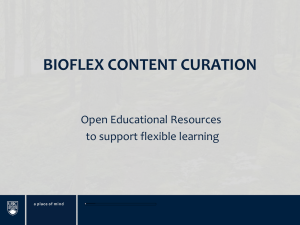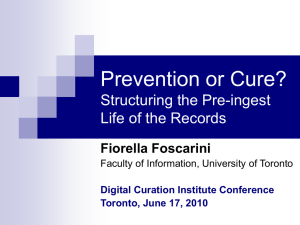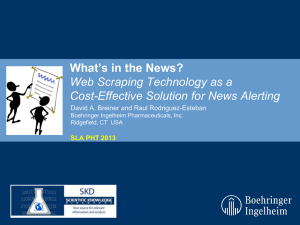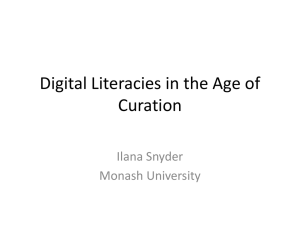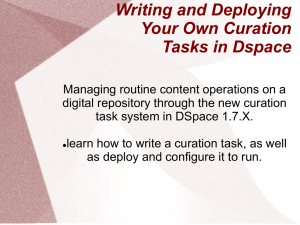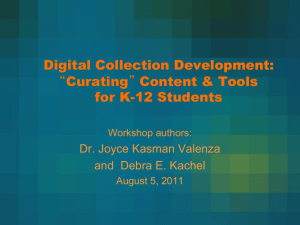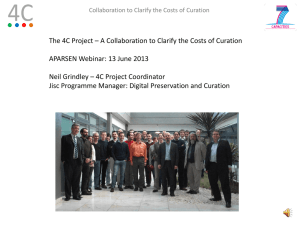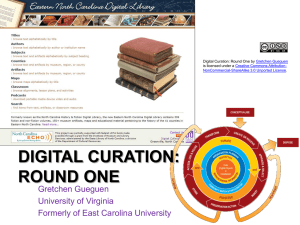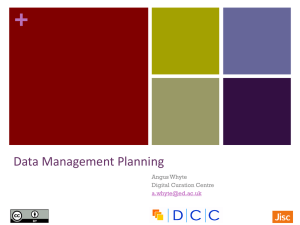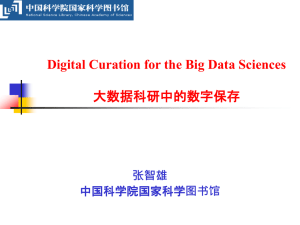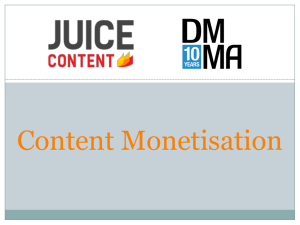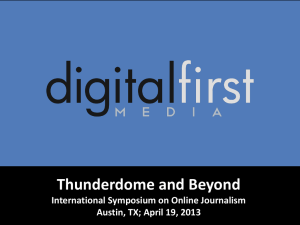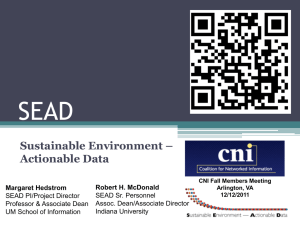Digital Curation - Society of American Archivists
advertisement
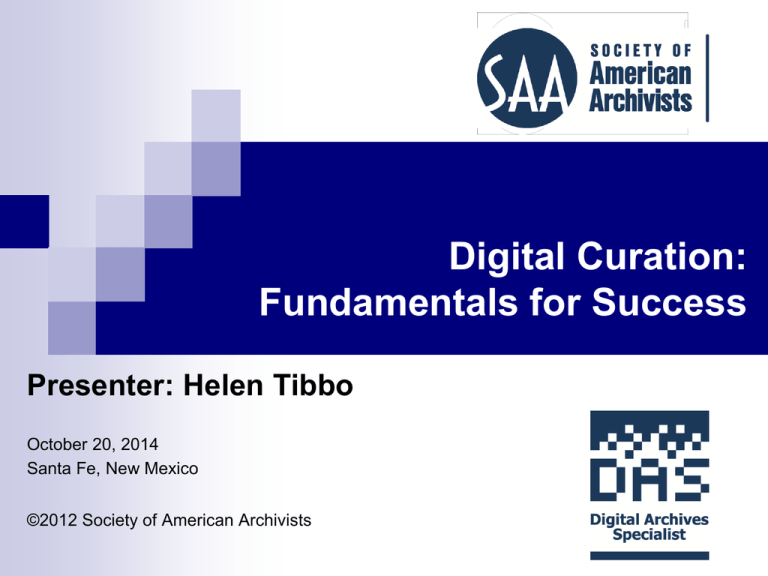
Digital Curation: Fundamentals for Success Presenter: Helen Tibbo October 20, 2014 Santa Fe, New Mexico ©2012 Society of American Archivists Digital Archives Specialist (DAS) Curriculum and Certification Program offered by SAA: Foundational Courses—must pass 4 Tactical and Strategic Courses—must pass 3 Tools and Services Courses—must pass 1 Transformational Courses—must pass 1 Course examinations are administered online 1 Welcome and Today’s Overview ■ ■ ■ ■ ■ Review definitions Building Blocks for Digital Curation Programs A break mid-morning and mid-afternoon Lunch around 12:00 End by 5:00pm 2 Course Description This workshop will review the concepts, principles and practices of digital curation necessary for effectively managing digital objects, including archival records, across generations of technology. This workshop is an foundational course. Suggested follow-on DAS courses include: ▪ Digital Curation: Planning and Sustainable Futures ▪ Electronic Records Management ▪ Digital Archives and Digital Libraries 3 DAS Core Competencies Addressed #1: Understand the nature of records in electronic form, including the functions of various storage media, the nature of system dependence, and the effect on integrity of records over time. #2: Communicate and define requirements, roles, and responsibilities related to digital archives to a variety of partners and audiences. #5: Plan for the integration of new tools or successive generation of emerging technologies, software and media. #7: Provide dependable organization and service to designated communities across networks. 4 Course Goals Understand the general scope of digital curation as an area of professional activity Explore relevant concepts for building sustainable digital curation programs Consider the components of digital curation Identify roles and responsibilities of a range of digital curation stakeholders 5 Definitions: Digital Curation “maintaining and adding value to a trusted body of digital information for future and current use” Active management and appraisal over entire life cycle Builds upon underlying concepts of digital preservation Emphasizes opportunities for adding value through annotation and continuing resource management Preservation is a curation activity - both are concerned with managing digital resources with no significant (or only controlled) changes over time Source: JISC 6 Data Curation + Digital Preservation Digital Curation Original DCC definition, 2004 7 Definitions: Data Curation “Active and on-going management of data through its life cycle of interest and usefulness to scholarship, science, and education…enables discovery, ensures quality, adds value, and provide for re-use over time” (University of Illinois at Urbana-Champaign) Predates the digital community Value-added steps by curators to enhance utility Intersection of data science (curators) and research (producers and consumers) 8 Definitions: Digital Preservation “the active management of digital content over time to ensure ongoing access” (National Digital Information Infrastructure and Preservation Program Library of Congress) Encourage quality creation by producers Document actions taken over the life of digital objects Ensure access over time Handshakes across generations of technology Proven technologies for preservation to contemporary for access 9 What Is Digital Curation? “the active management and preservation of digital resources…for current and future generations of users.” Digital Curation Centre. “What is Digital Curation?” http://www.dcc.ac.uk/about/what/ of the term “digital curation” reflects increasing confluence of several distinct communities Adoption From Christopher A. Lee, DigCCurr Professional Institute “[Digital] Curation…requires a commitment to undertake duties of stewardship. However it should be noted that such a commitment is influenced by a complex array of factors including social, cultural, political, organizational, financial and legal as well as technical issues.” Patel, Coles, Giaretta, Rankin, and McIlwrath, 2009 10 Terms Related to Digital Curation Data Curation Data Management Digital Archiving Digital Libraries Digital Preservation Digital Stewardship Use the language of your audience What we do is as important as what it’s called 11 Activities Related to Digital Curation ■ Care of physical media ■ Computer-supported cooperative work (CSCW) ■ Data Management ■ Digital archiving ■ Digital forensics & data recovery ■ Management of information systems (MIS) ■ Standards development Source: C. Lee 12 Professions Related to Digital Curation ■ Art & museum curation ■ Biocuration ■ Institutional & manuscripts archivists ■ Lawyers & auditors ■ Librarianship (esp. digital) ■ Physical science data archives ■ Social science data archives Source: C. Lee 13 Research Related to Digital Curation ■ Cyberinfrastructure and eScience ■ Hardware & software interoperability ■ Medical information (e.g. health records, imaging, informatics) ■ Research on documents & document-centric computing Source: C. Lee 14 Digital Curation + Archival Records Electronic Records Management 15 Building Blocks for Digital Curation Programs 1. 2. 3. 4. 5. 6. 7. 8. 9. 10. 11. 12. 13. Conceptual frameworks Organizational infrastructure Technological infrastructure Resource framework Policy framework Roles & responsibilities Stakeholders Content characteristics Standards Holistic workflows Strategy & planning Outreach & advocacy Ongoing evaluation 16 1. Conceptual Frameworks Community Documents and Standards Models DPOE (Digital Preservation Outreach and Education) Electronic Records Lifecycle Specification (ERLS) DCC Curation Lifecycle Model Digital Preservation Three-legged Stool (Kenney and McGovern, 2003) Standards Trusted Digital Repositories 2002 (TDR) Open Archival Information System (OAIS) Reference Model ISO Trustworthy Digital Repositories Audit and Certification 2012 17 Digital Preservation Outreach and Education (DPOE) Model Identify the types of digital content you have Select the portion of your content to be preserved Store your selected content for the long term Protect your content every day & in emergencies Manage content across time & technologies Provide access to your digital content over time 18 Electronic Records Lifecycle Specification (ERLS) Source: Robek et al., 1995 [reproduced Koiallka, 2003.] 19 DCC’s Digital Curation Lifecycle Model http://www.dcc.ac.uk/docs/publications/DCCLifecycle.pdf 20 DPM Workshop’s Three-legged Stool (how?) (how much?) (what?) Adapted from: Kenney and McGovern, 2003 21 2. Organizational Infrastructure Best framework is 2002 Trusted Digital Repositories Best reflected in: o o o o o mission policy development and implementation long-term planning institutional commitment participation by Producers and Consumers Adapted from: Kenney and McGovern, 2003 22 Attributes of a TDR OAIS Compliance Administrative Responsibility Organizational Viability Financial Sustainability Technological and Procedural Suitability System Security Procedural Accountability 23 3.Technological Infrastructure Most comprehensive framework: Open Archival Information System OAIS o o o o o o is a combination of: hardware and software packaging and re-packaging network, security, and services functions and workflow procedures, protocols, documentation technical and curation skills Adapted from: Kenney and McGovern, 2003 24 OAIS Reference Model (high level) 25 Current Tools (examples) ■ ■ ■ ■ ■ ■ ■ Archivematica http://archivematica.org/wiki/index.php?title=Main_Page ArchivesSpace http://archivesspace.net BitCurator http://www.bitcurator.net TRAC review self-assessment tool (on-line) DRAMBORA http://www.repositoryaudit.eu/ Duke Data Accessioner http://coptr.digipres.org/Duke_Data_Accessioner POWRR, Preserving (Digital) Objects With Restricted Resources http://digitalpowrr.niu.edu/tool-grid/ 26 4. Resources Framework $$$$ Several are in development LIFE and LIFE2 The Keeping Research Data Safe (KRDS) Benefits Analysis Toolkit 4C Project Includes: o o o o Staff, training, and development Technology and related developments Outreach and designated community support Other digital object curation management Adapted from: Kenney and McGovern, 2003 27 5. Digital Curation Policy Framework ■A policy framework to express the three-legged stool for your organization ◻ Links to other policy documents and standards ◻ Includes local definition of terms ◻ Includes roles and responsibilities ◻ And other components 28 Benefits of Developing Policies Digital Curation Team – three legs Defines institutional commitment Demonstrates compliance – requirements Manages expectations – stakeholders Defines issues and challenges Raises awareness – timing Identifies roles and responsibilities Builds courtesy DPM workshop 29 Examples of Policy Areas ■ ■ ■ ■ Archival Storage Collection Development IP and Rights Preservation Planning Records Management Service Level Agreements Submission Agreements Technical Infrastructure IT Environment Disaster Recovery Preparedness Discovery and Use Use Agreements 30 6. Roles and Responsibilities Effective collaboration requires the definition of roles Define the Roles Appoint people to the roles Roles might include more than one person One person might have many roles Role does not equal Job Description Be Clear of your Role during different phases of Digital Curation 31 Capabilities for Digital Curation Roles Address legal issues Balance risks and costs Build/maintain registries Collaborate Define good practice Design object packages Develop competencies Develop polices Develop programs Develop workflows Devise strategies Enable interoperability Identify dependencies Invest in solutions Investigate problems Manage metadata Manage repositories Monitor technology Promulgate standards Raise awareness 32 7. Stakeholders Funders and broader community supporters Advocates Strategic decision makers Organizational direction setters High-level Administrators Users of Content Creators of Content 33 Raising Awareness Education ◻ ◻ ◻ ◻ Training, Training, and More Training In-Class and Online Modules Annual Recertification System template data entry practicum Community ◻ ◻ ◻ ◻ ◻ ◻ of Users/Liaisons Members only spaces Mailing lists Listservs Wikis Blogs Social media 34 Message to the Masses Publications Annual Reports Brochures Flyers FAQs Presentations Press Releases Sales brochures Talking points White papers Recruit Advocates Best practices End user case studies Enlist stakeholders Satisfied content creators 35 8. Characteristics of Content Digital Objects have Bit streams Creators Intellectual content Rights Technical specs Uses AND associated metadata 36 Building Blocks 9-13 9. Standards (Relevant Examples) 10. 11. Holistic workflows Strategy & planning 12. Preservation planning, self-assessment, external audits, and more Outreach & advocacy 13. PREMIS: Preservation Metadata Implementation Strategies, 2005 plus updates TRAC: Trustworthy Repositories Audit and Certification, 2007 and ISO 16363: 2012 You will need to engage a variety of stakeholders at various points in the digital content lifecycle with various clear and terse messages Ongoing evaluation Assessment is the basis of self-understanding and improvement 37 WRAP-UP PLANS FOR TOMORROW A positive attitude toward change and a flexible response structure
